Influence Measures for GLM Logit¶
Based on draft version for GLMInfluence, which will also apply to discrete Logit, Probit and Poisson, and eventually be extended to cover most models outside of time series analysis.
The example for logistic regression was used by Pregibon (1981) “Logistic Regression diagnostics” and is based on data by Finney (1947).
GLMInfluence includes the basic influence measures but still misses some measures described in Pregibon (1981), for example those related to deviance and effects on confidence intervals.
[1]:
import os.path
import pandas as pd
import matplotlib.pyplot as plt
from statsmodels.genmod.generalized_linear_model import GLM
from statsmodels.genmod import families
plt.rc("figure", figsize=(16, 8))
plt.rc("font", size=14)
[2]:
import statsmodels.stats.tests.test_influence
test_module = statsmodels.stats.tests.test_influence.__file__
cur_dir = cur_dir = os.path.abspath(os.path.dirname(test_module))
file_name = "binary_constrict.csv"
file_path = os.path.join(cur_dir, "results", file_name)
df = pd.read_csv(file_path, index_col=0)
[3]:
res = GLM(
df["constrict"],
df[["const", "log_rate", "log_volumne"]],
family=families.Binomial(),
).fit(attach_wls=True, atol=1e-10)
print(res.summary())
Generalized Linear Model Regression Results
==============================================================================
Dep. Variable: constrict No. Observations: 39
Model: GLM Df Residuals: 36
Model Family: Binomial Df Model: 2
Link Function: Logit Scale: 1.0000
Method: IRLS Log-Likelihood: -14.614
Date: Fri, 05 Dec 2025 Deviance: 29.227
Time: 18:08:43 Pearson chi2: 34.2
No. Iterations: 7 Pseudo R-squ. (CS): 0.4707
Covariance Type: nonrobust
===============================================================================
coef std err z P>|z| [0.025 0.975]
-------------------------------------------------------------------------------
const -2.8754 1.321 -2.177 0.029 -5.464 -0.287
log_rate 4.5617 1.838 2.482 0.013 0.959 8.164
log_volumne 5.1793 1.865 2.777 0.005 1.524 8.834
===============================================================================
get the influence measures¶
GLMResults has a get_influence method similar to OLSResults, that returns and instance of the GLMInfluence class. This class has methods and (cached) attributes to inspect influence and outlier measures.
This measures are based on a one-step approximation to the the results for deleting one observation. One-step approximations are usually accurate for small changes but underestimate the magnitude of large changes. Event though large changes are underestimated, they still show clearly the effect of influential observations
In this example observation 4 and 18 have a large standardized residual and large Cook’s distance, but not a large leverage. Observation 13 has the largest leverage but only small Cook’s distance and not a large studentized residual.
Only the two observations 4 and 18 have a large impact on the parameter estimates.
[4]:
infl = res.get_influence(observed=False)
[5]:
summ_df = infl.summary_frame()
summ_df.sort_values("cooks_d", ascending=False)[:10]
[5]:
| dfb_const | dfb_log_rate | dfb_log_volumne | cooks_d | standard_resid | hat_diag | dffits_internal | |
|---|---|---|---|---|---|---|---|
| Case | |||||||
| 4 | 1.073359 | -0.930200 | -1.017953 | 0.429085 | 3.681352 | 0.086745 | 1.134573 |
| 18 | 0.959508 | -0.827905 | -0.847666 | 0.328152 | 3.055542 | 0.095386 | 0.992197 |
| 19 | -0.259120 | 0.202363 | -0.004883 | 0.066770 | -1.150095 | 0.131521 | -0.447560 |
| 29 | 0.236747 | -0.194984 | 0.028643 | 0.065370 | 0.984729 | 0.168219 | 0.442844 |
| 31 | 0.116501 | -0.099602 | 0.132197 | 0.055382 | 0.713771 | 0.245917 | 0.407609 |
| 24 | -0.128107 | 0.041039 | -0.100410 | 0.051950 | -1.420261 | 0.071721 | -0.394777 |
| 13 | -0.093083 | -0.009463 | 0.177532 | 0.046492 | -0.847046 | 0.162757 | -0.373465 |
| 23 | -0.196119 | 0.127482 | 0.035689 | 0.031168 | -1.065576 | 0.076085 | -0.305786 |
| 33 | -0.088174 | -0.013657 | -0.002161 | 0.027481 | -1.238185 | 0.051031 | -0.287130 |
| 6 | -0.092235 | 0.170980 | 0.038080 | 0.026230 | 0.661478 | 0.152431 | 0.280520 |
[6]:
fig = infl.plot_influence()
fig.tight_layout(pad=1.0)
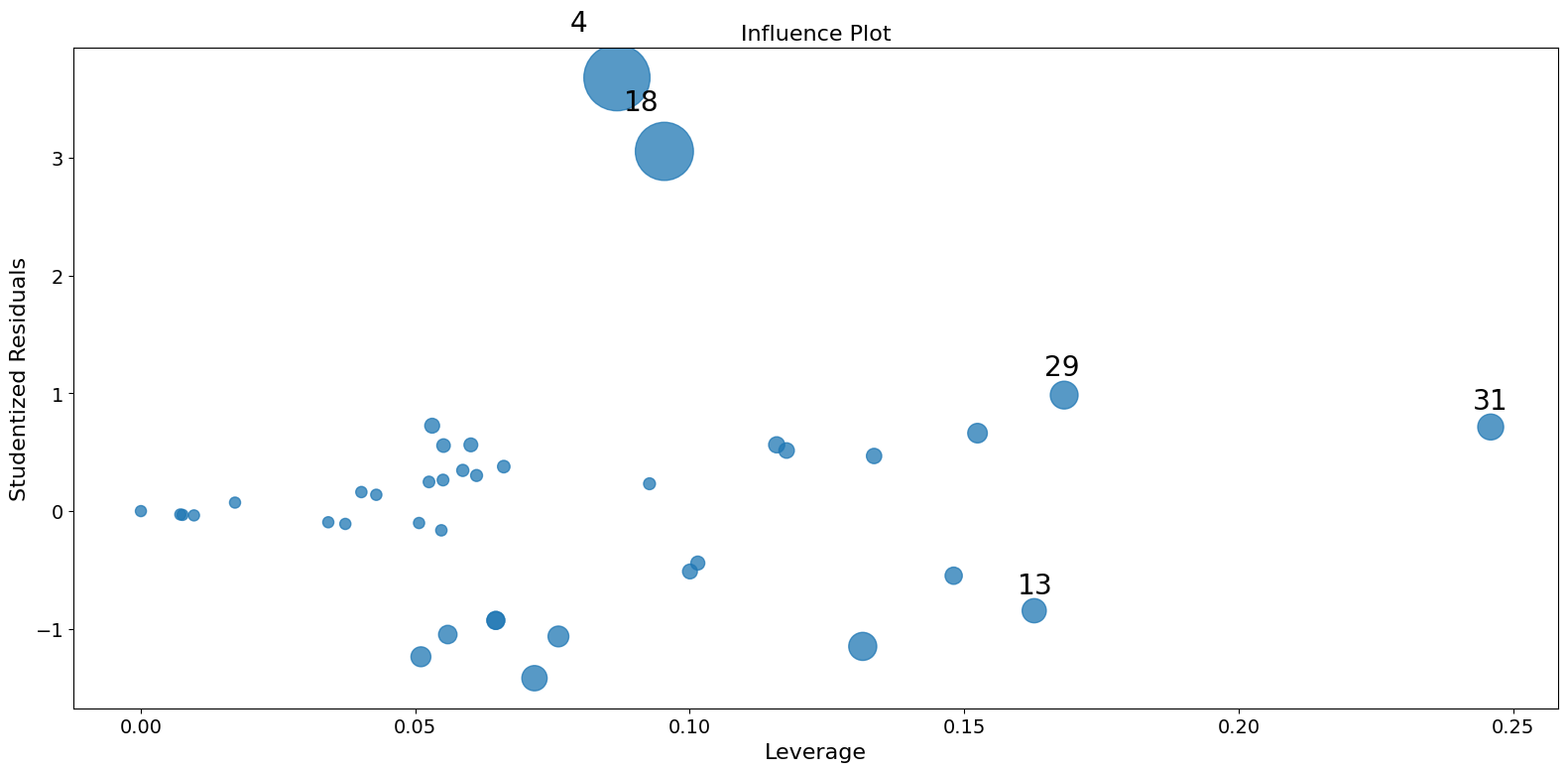
[7]:
fig = infl.plot_index(y_var="cooks", threshold=2 * infl.cooks_distance[0].mean())
fig.tight_layout(pad=1.0)

[8]:
fig = infl.plot_index(y_var="resid", threshold=1)
fig.tight_layout(pad=1.0)
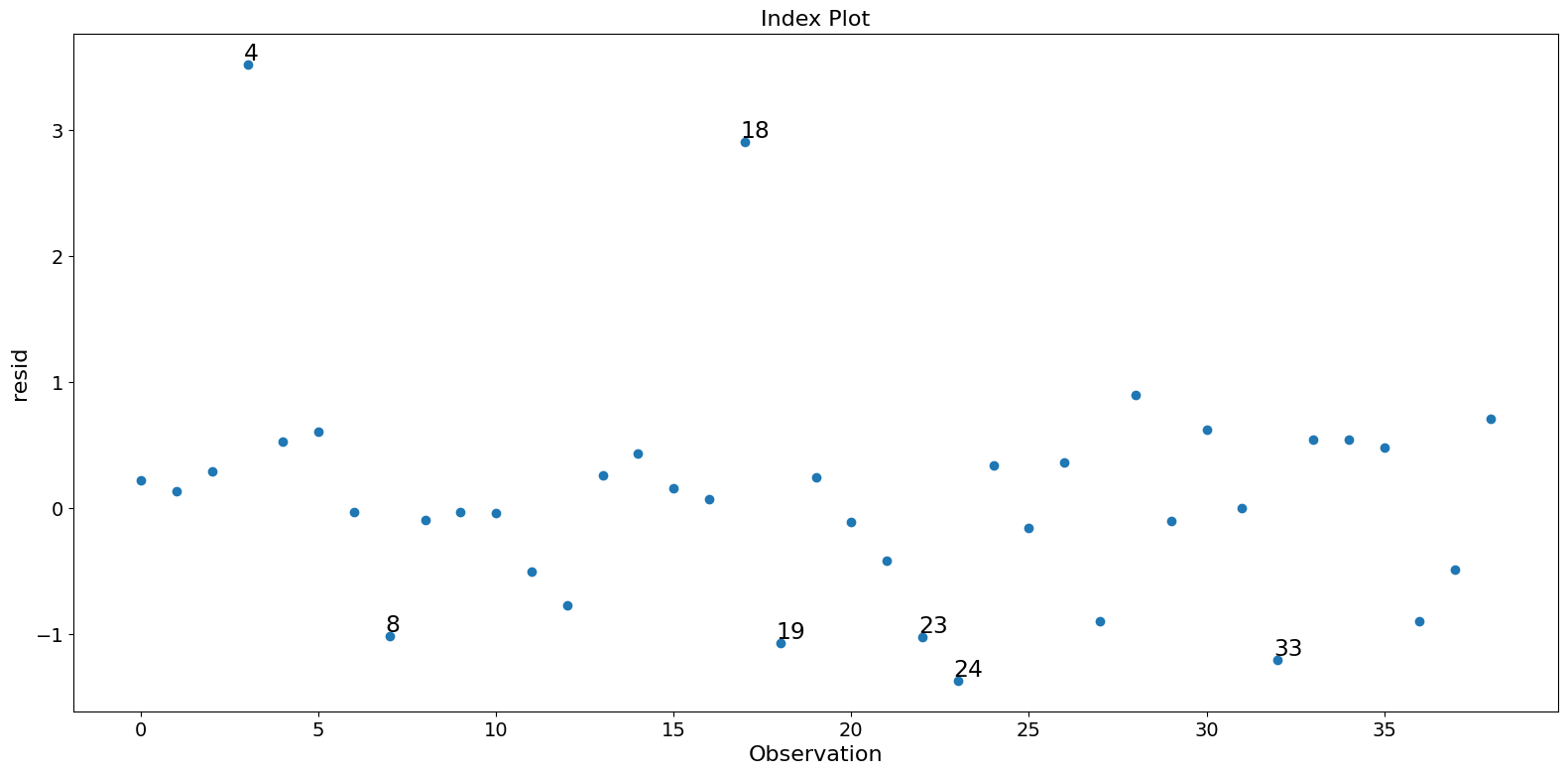
[9]:
fig = infl.plot_index(y_var="dfbeta", idx=1, threshold=0.5)
fig.tight_layout(pad=1.0)
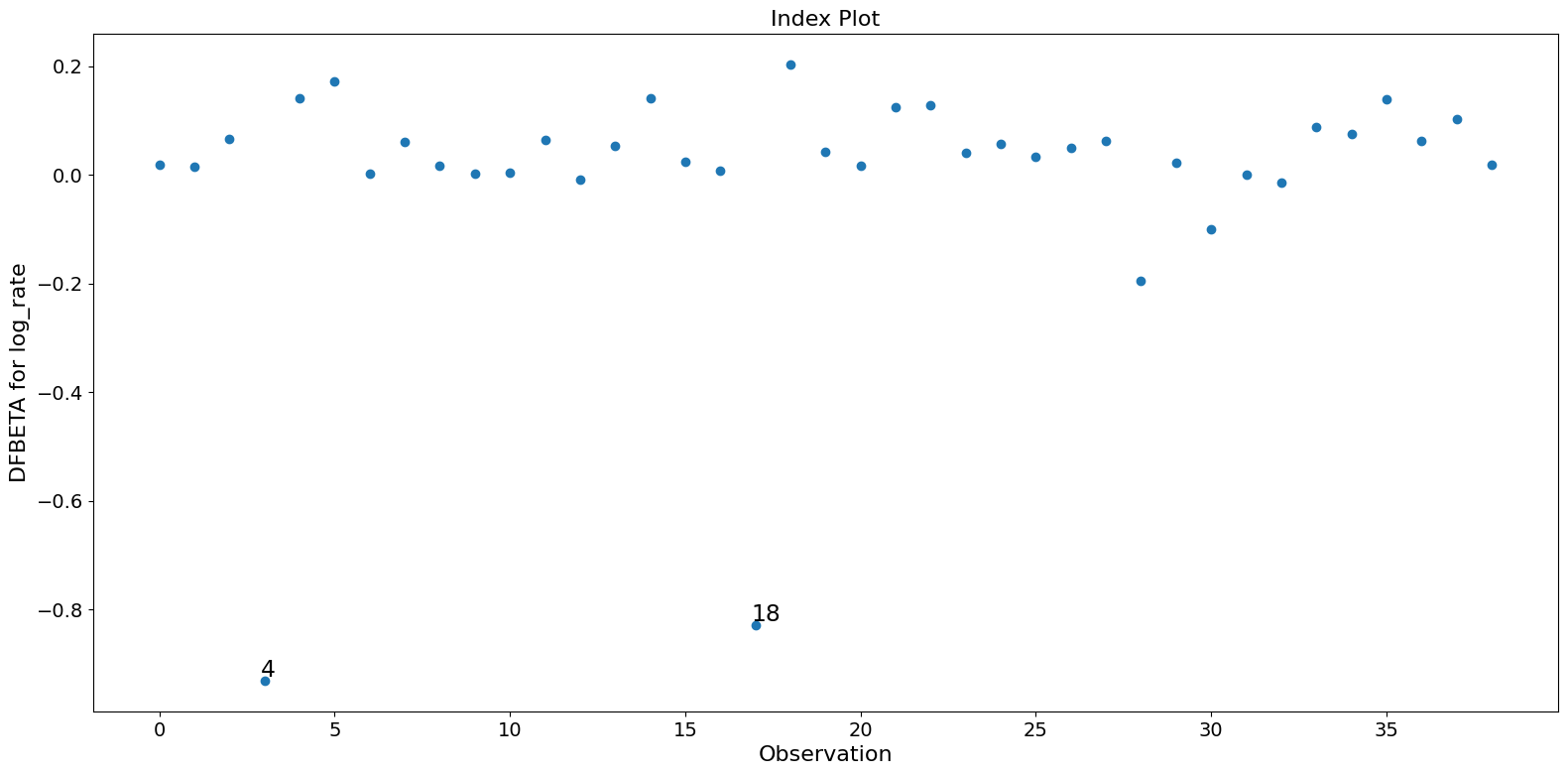
[10]:
fig = infl.plot_index(y_var="dfbeta", idx=2, threshold=0.5)
fig.tight_layout(pad=1.0)
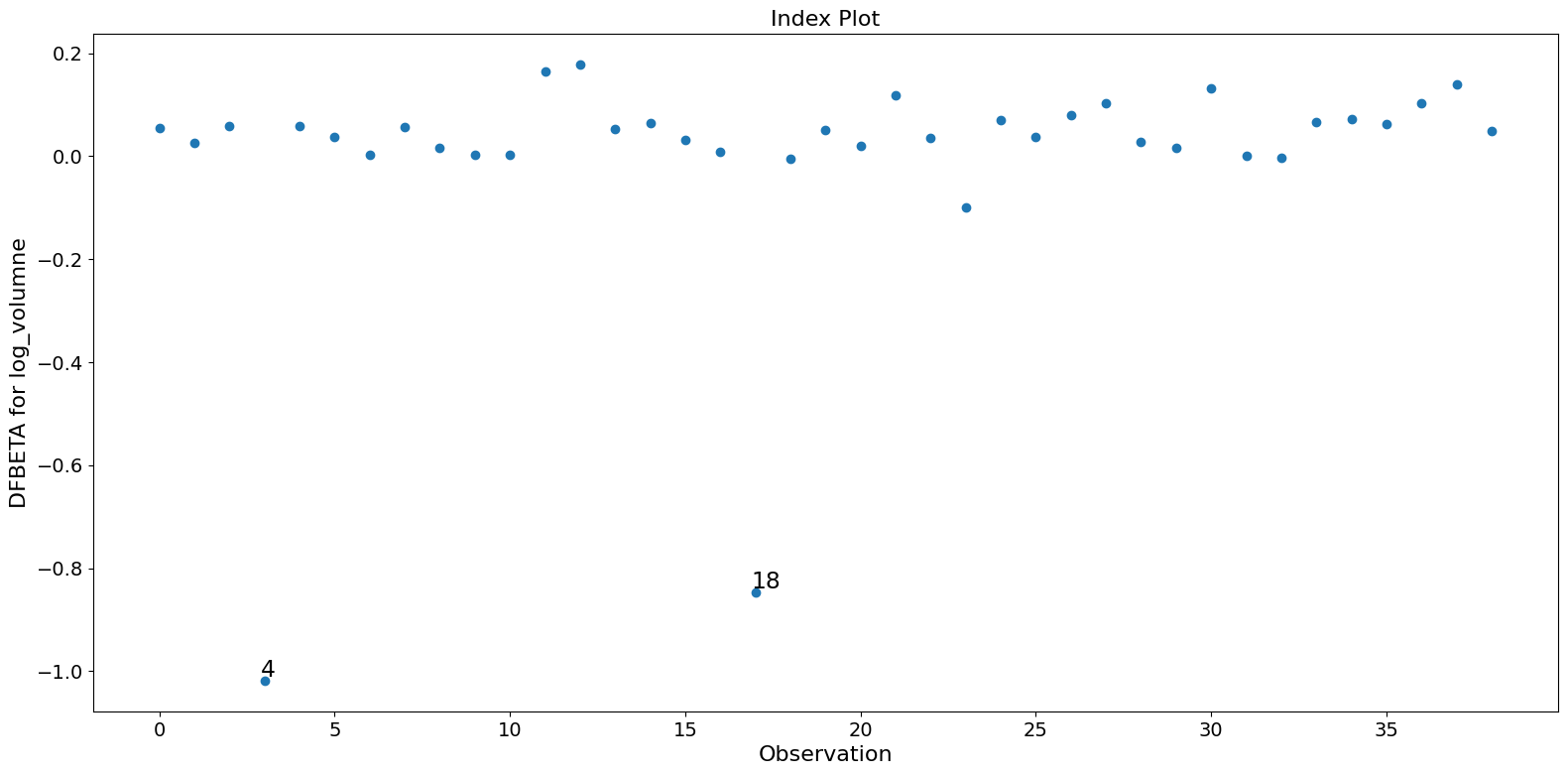
[11]:
fig = infl.plot_index(y_var="dfbeta", idx=0, threshold=0.5)
fig.tight_layout(pad=1.0)
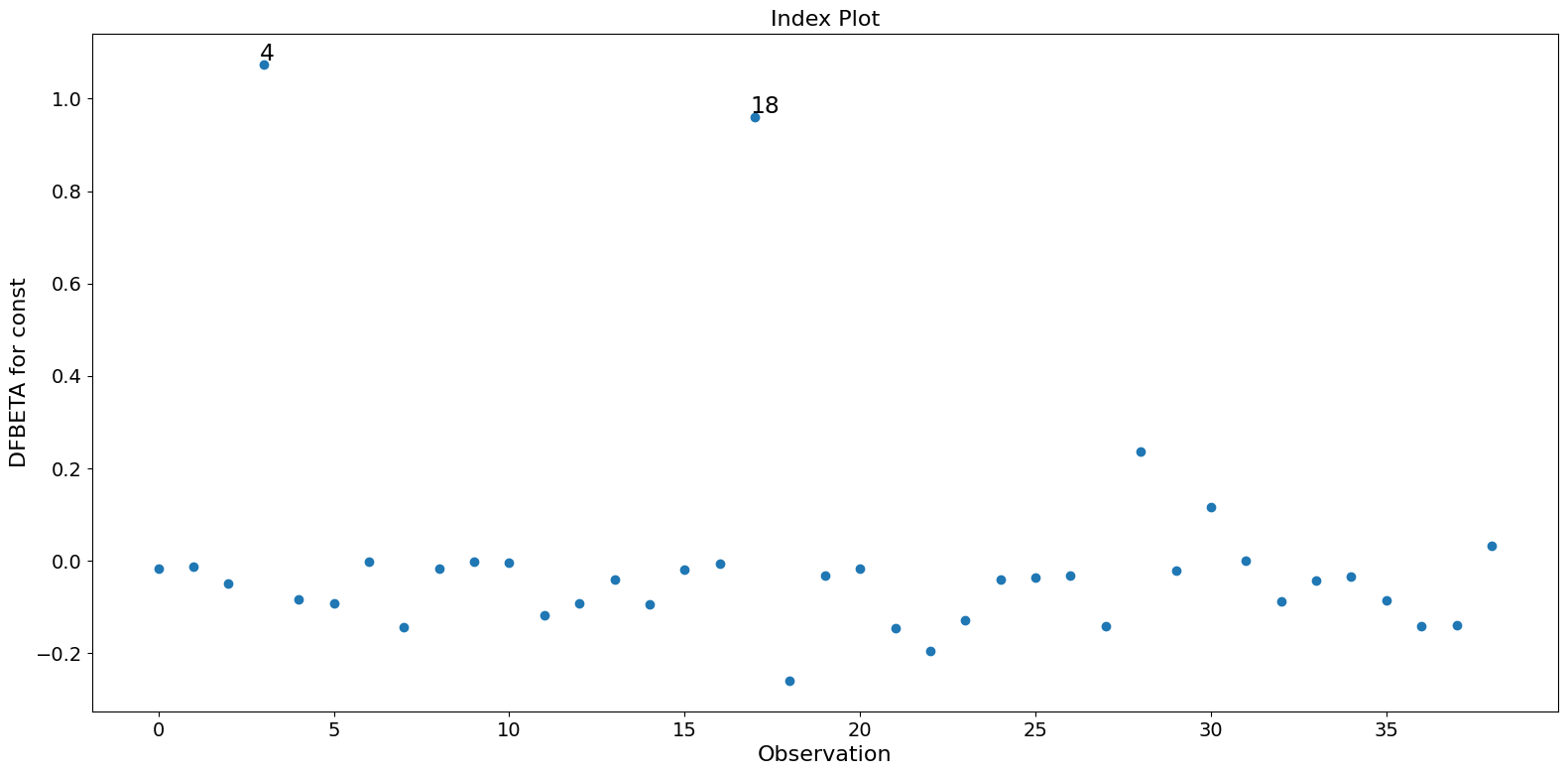
[ ]: